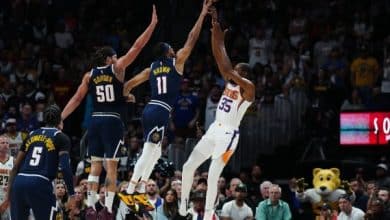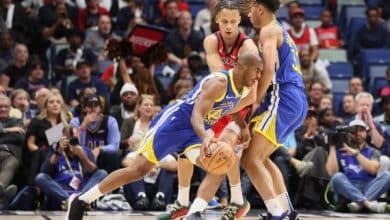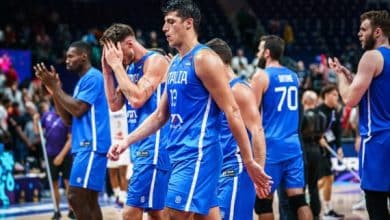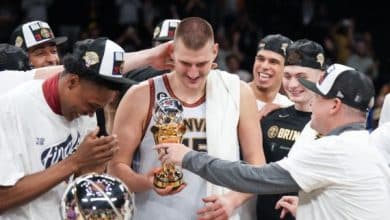
He has a polite way of looking you up and down. The furtive glance of the cobra before the fatal bite. Then the black gaze rushes towards its prey. A vision of hell. This skull reminiscent of Lieutenant Kojak finishes destroying you. His smile, he dropped it on the other side of the Atlantic. Tremble, here Sedale Threattborn September 10, 1961.
Threatt is 35 years old in 1996. Scars on his arms, the legacy of the many trench wars fought on the NBA floors. 930 games in total in the regular season and 54 in the playoffs. What matters with him are not the points you score on a scoreboard but the little signs you notice at the end of a game. A smile on the lips, compliments from teammates, a friendly pat from the coach… “I like to win”he said.
The doors of the NBA closed before him, as strangely as they had opened one fine day in June 1983. So Sedale crossed the Atlantic Ocean, closed his suitcase of memories, looking the other world, the old one, straight in the eyes. Wide open. Ears too. “I had already seen him in a match”whispers Charles Biétry, the boss of PSG Racing Basket, who brought him to the capital. “I won't tell you that I dreamed about it every night… We were on several players of this level. As soon as he signed, I said that he could not transform the team on his own.”
And it matters little that Paris is a symbolic place in his secret notebook. It was on a Parisian floor, that of Bercy, that Sedale fought his first battle, wearing the Lakers jersey. It was also on this occasion that he first met his Parisian teammate Richard Dacoury, who was then from Limoges. It was in 1991 for the McDonald's Open. Memories of the “Dac”. “When we saw each other again, he recognized me and said: “Yeah, I remember you, you had a good game against us.”. “He was an uncontrollable player, capable of setting a match alight.”
A juggler promoted to magician
A juggler who was once asked to become a magician. Without a thorough medical examination, the 6-foot-2, 175-pound guard from Atlanta and trained at West Virginia Tech would never have captured the lights of the court with such brilliance. His look of a little terror had never inspired screams of hysteria from the least fan. Many forwards fled at the sight of him.
Then came the shock. October 1991, then. The Lakers, the last NBA finalists, once again appeared as the Bulls' main competitors after a very perilous trip to Paris, as part of the McDonald's Open. The defeat against Chicago (1-4) a few months earlier had left its mark. Visible. Deprived of oxygen by the Michael Jordan-Scottie Pippen tandem, Magic Johnson felt the need to breathe from time to time. No one knew at the time that his HIV status, announced on November 6, 1991, would keep him away from the courts.
Jerry West, GM of the Lakers and Pygmalion of the Californian franchise, rummages through his computer data to find a guard capable of slipping quietly into Magic's shoes for a handful of minutes. Without, however, capturing the beams of light coming from the ceiling of the Inglewood Forum, the legendary arena of the 1988 NBA champions. One name stands out to him: Sedale Threatt.
Drafted in 139th position!
His defensive footwork, courage and confident dribbling make him the ideal choice. His past also speaks in his favor. Especially his last three seasons in Seattle (12.7 pts and 3.4 apds in 1990-91 on 25.8 min). Sedale Threatt went to a good school: Sixers, Bulls, Supersonics. In the 1983 Draft, Philadelphia had selected him 23rd in the sixth round (139th pick). Trained in a modest NAIA college, the Georgia native finished his studies by leaving a tough slate for college defenses. His 2,488 points were the best total in West Virginia Tech history. Not enough to impress the gallery on draft day.
It was hard to see how Sedale Threatt could get minutes on a roster that included Julius Erving, Moses Malone, Andrew Toney, Maurice Cheeks and Marc Iavaroni. Cheeks, a ball-stealing specialist, would become his inspiration. Threatt took advantage of the cascade of injuries that decimated the Sixers' roster to average 22 minutes on the court and score 6.9 points. He would finish his rookie season with 45 games under his belt (3.3 pts on 10.3 min). A pleasant hazing.
The arrival the following season of a rookie named Charles Barkley changed the face of the franchise. They were the only two Sixers to play all 82 regular-season games in 1984-85. From then on, the Threatt threat would always be taken seriously off the bench. Sedale was happy, often. Injured, sometimes. But always eager to learn.
Los Angeles shakes up No. 1 seed
When he left the Sixers on December 31, 1986 for Chicago, traded for Steve Colter and a second-round draft pick, his mission was simple: to give Michael Jordan a hard time, who was dominating the top scorers' rankings (37.1 pts) in his third season with the Bulls.
“MJ” massacres each of his bodyguards in training. Humble and courageous, Sedale accepts the challenge. And takes advantage of the 40 matches played in the Illinois franchise to consolidate his stats (7.9 pts and 4.4 pds in less than 20 minutes). Having become a good bargaining chip, he will go from the Bulls to the Sonics – traded for Sam Vincent in February 1988 – and from the Sonics to the Lakers – for three second round draft picks in October 1991.
His stock is rising. Jerry West sees him settling into the shadow of Magic. But the future of the LA magician darkens a few weeks later with an announcement that creates astonishment all over the world. And that's how Threatt finds himself in the spotlight. The famous jersey with the number 32 disappears. The Lakers are orphans. A silent heir, Sedale takes his courage in both hands.
He is 30 years old and finds himself at the controls of the most beautiful dream machine of the 80s. He will not give friendly slaps to Jack Nicholson but will honorably fulfill his task, for two years, as a starter (15.1 pts, 48.9% shooting, 7.2 pds and 2 ints in 1991-92). He listened to Magic's advice while getting rid of embarrassing and compromising comparisons. Assists, interceptions and minutes played become his preserve. He calls himself a “winner” and wants to communicate this fervor to his teammates. He is nicknamed “The Thief” for his ability to steal balls.
Shaq's arrival pushes him out
During the 1992-93 season, which saw Randy Pfund replace Mike Dunleavy (neo-Buck) on the bench, Sedale became the second player in Lakers history, after Magic, to rank No. 1 in points (15.1), assists (6.9) and steals (1.7). He set his career high in points in March against the Knicks (42) and his playoff high in points (35) in Game 1 of the first round of the Suns-Lakers playoffs, while Phoenix was without Kevin Johnson.
Los Angeles (39-43), 8th in the West, created a sensation by taking the first two games of the series on the court of the number 1 of the regular season before dropping the next three, the fifth only in overtime (112-104). Reassuring. Sedale has a good little jumper, serves his teammates well and does not give up easily in defense.
When the Lakers undertook the renovation of the back line, Sedale stayed to make the transition. Nick Van Exel, Eddie Jones and Anthony Peeler would clearly point to him as one of the main explanations for their progress. The next generation quickly reached adulthood. Ready to fly on its own in the company of a monster, Shaquille O'Neal. The arrival of the Magic pivot in LA in 1996 caused the salary cap to explode, forcing the Lakers to unload the boat a little. Sedale, far from falling into nostalgia, left. Silently. As he had come. The Lakers had become ambitious again, as they had been when he arrived. Threatt reappeared in Paris, in the capital that had made him a prince. “We stepped on each other's toes a little bit,” explains Laurent Sciarra, “because we play in the same place. He has good address, he sees the game well, there is always a challenge to be opposed to him. We watch, we learn. On defense, he has incredible hand speed.”
Three small matches with Paris and then he leaves
Hands capable of snatching a crown of which he has always known only the legends. Not the intoxication. With PSG Racing Basket, he has his eye on a French champion title. But the day the Parisians are crowned, Sedale is a Rocket… The Pro A adventure ends after three unfortunate matches (11 pts). Precarious form. Lack of motivation. Tendinitis in the knee. Operation in October. Return to the United States.
Houston is stripped of feathers at the back. Derek Harper's trade from Dallas has failed. Brent Price's season ends abruptly. Clyde Drexler and Emanual Davis are also on the sidelines. So, Carroll Dawson, vice president of basketball operations, makes a call to Sedale's agent. Miami comes forward but Houston has the last word. The contract is signed on March 2, 1997, the gig will earn him less than $100,000. The salary of a bench player, used 16 minutes on average (3.3 pts).
In the spring of 1997, Threatt participated in his twelfth and final playoff campaign. For only the third time, he got past the first round. Defeated 4-2 against the Jazz in the Western Conference finals. Cut by the Rockets in October, the No. 2 (formerly 9 and 3 with the Sixers, 3 with the Bulls and Lakers and 4 with the Sonics) would reappear in Europe, in Greece and then in Switzerland.
In 2006, he took over the reins of an Australian team after having exercised his talents in the antipodes, in his late forties. With the logistical support of the And1 brand, he organized several camps there.
Thirteen years after ending his NBA career, Sedale Threatt leaves a memory full of contrasts. He was the last player drafted in the 6th round to play in the League. He rubbed shoulders with the greatest: Dr J, Moses Malone, Barkley, Jordan, Pippen, Magic, Worthy, Drexler, Olajuwon… The impossible was asked of him: to succeed the most fabulous playmaker in history. He was in a way the best player on one of the worst Lakers teams, a mix of young talents (Elden Campbell, Vlade Divac…) and stars on the decline. A faltering dynasty whose shine would tarnish for many years to come.
Threatt made the transition between two glorious eras. From the Showtime era, only Byron Scott, James Worthy and AC Green remained. He passed the baton to the next generation. No doubt his performances in the California jersey would have been re-evaluated if he had not had to burden himself with the worst of comparisons.
Sedale Threatt is said to have 14 children…
In Seattle, it is said that Sedale used to sleep in Gary Payton's car after a night out so he could get to practice faster the next day. It is also said that the night was the friend of this character described as difficult…
And then there was this article in the New York Times in October 2007 with a killer headline: “Little Ties Threatt Jr. to His Father Beyond Their Names.” Sedale Jr. is the child of Sedale Sr. and Nadine Jackson. According to Nadine, the former PSG Racing Basket player had 14…
In 2000, he was sentenced to six months in prison after pleading guilty to failing to pay several child support payments. Sedale Jr.'s parents met in Philadelphia in the mid-1980s at a pickup game. Nadine played basketball at the University of Massachusetts.
Nicole Threatt was Sedale's wife. In 1996, she remarried rap producer Dr. Dre.
Stats
14 years old
951 matches (304 times starter)
9.8 pts, 1.8 rbd, 3.8 pds, 1.2 int, 0.1 ct
48.5% shooting, 29.3% 3-pointers, 81.5% free throws
Records
42 points in New York on 10.3.92
11 rebounds in New York on 10.3.93
15 passes (three times)
7 interceptions in Portland on 1/21/94
3 blocks (four times)












